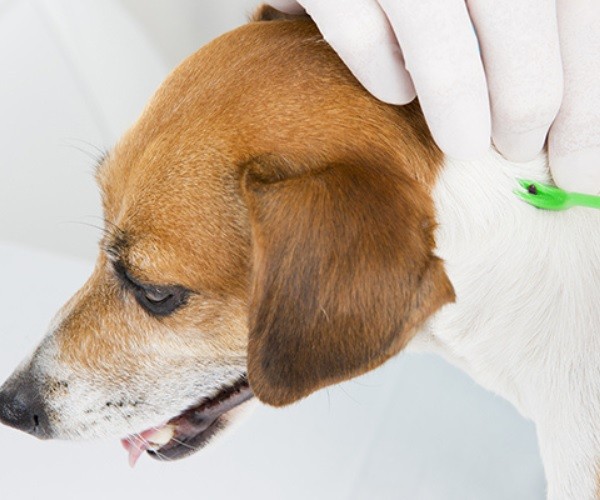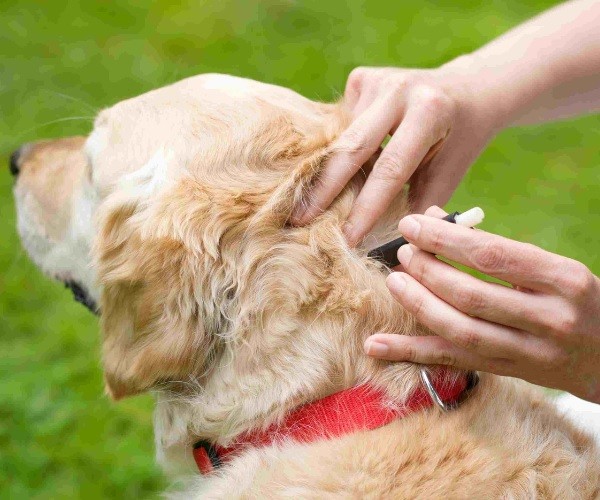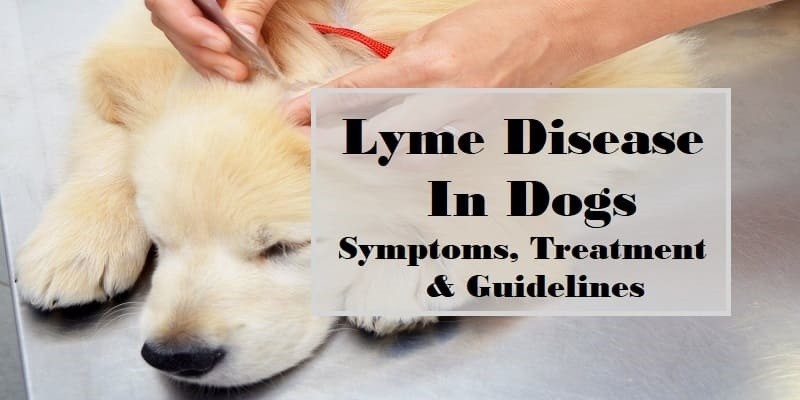Lyme disease in dogs is one of the most common infections that can occur anywhere irrespective of the weather or other conditions. Lyme disease is carried by ticks, but they are not the actual causative organism. Instead, the bacterium Borrelia burgdorferi is responsible for the infection.
The bacterium gets into the tick, and the tick latches on to the dog’s skin through a bite and transmits the bacterium into the bloodstream. After it enters the bloodstream of the dog, it targets the joints and organs.
Symptoms of Lyme disease in dogs

General symptoms of Lyme disease in dogs include:
- Fever
- Fatigue
- Loss of appetite
- Swollen joints
- Stiff and painful joints
- Inability to move/walk
Specific symptoms of Lyme disease in dogs do not start to show until about two to five months after the initial infection from the tick host. There are three stages of the Lyme infection in dogs with some particular symptoms attached to each stage:
Acute Lyme Disease
At this stage, your dog would start by showing symptoms of fever, lose interest in favorite activities, and be unmotivated to move or go on walks. You would also notice a reduction in their appetite – the dog may stop finishing its usual ration or not touch the food at all.
The dog can also have swollen lymph nodes and painful joints that would feel warm when you touch it. Your dog might drag one leg when it is walking.
Subacute Lyme Disease
At this stage, the movement restriction would be advanced, and your dog would be able to walk barely. There can be pain in some joints or all the joints.
Chronic Lyme Disease
This is the last stage, and the infection would start affecting major organs such as the kidney, liver, and brain.
Testing for Lyme Disease in Dogs

Testing for Lyme disease in dogs can be tricky, depending on the stage of the infection. Usually, your vet will perform a blood test to check for antibodies created by the bacterium. If antibodies are present, it means that your dog has Lyme disease.
However, this test is not entirely foolproof as dogs that have just been recently infected may not have enough antibodies to show up in the trial. The same also goes for dogs in the end-stage that may not have enough antibodies to give a positive result.
The other type of test looks for the specific DNA of the causative bacterium. That can also come up with a false negative as the particular cells used may not contain the bacteria while it may be present in other joints.
Treatment

Treatment is targeted at reducing the symptoms
- The primary treatment for Lyme disease in dogs is the use of antibiotics. Doxycycline and amoxicillin are the most commonly used ones to treat the condition.
- It is crucial for the full dosage to be used or your dog will not be completely cured, and an incomplete treatment can make the remaining bacteria in the blood attack the dog’s body again.
- The treatment duration is generally from four to six weeks, but for more chronic cases, the treatment can last as long as eight weeks.
- Your vet is unlikely to prescribe a painkiller for your dog because if the antibiotics work effectively, the painful symptoms will resolve quite fast to give your dog relief.
- For chronic Lyme disease that has affected the kidneys, some urinary tests would be required to be able to prescribe appropriate medication.
- In the case of Lyme nephritis, a biopsy may be needed to determine the extent of damage, and the treatment method often includes fluid therapy, diet change, and antibiotics.
- Sometimes, Lyme disease may have progressed too far and destroyed the kidneys. In this case, you can still decide to try treatment with antibiotics, but it may not work.
- If your dog does not test positive for Lyme disease, you should not insist on using antibiotics for it as the symptoms can mimic that of other diseases. Also, the antibiotics’ side effects can give your dog other problems.
Prevention
Prevention is always better than cure, and you should consider ways to prevent your dog from getting Lyme’s disease:
- Get your dog vaccinated: If you live in an area where ticks are commonly found, you should consult your vet about getting your dog vaccinated. Several strains of the bacteria cause Lyme’s disease so your vet will be able to determine the best vaccine for your dog.
- Limit dog’s exposure: Try to control your dog’s solo walking area, especially if you live in a wooded area with trees shedding leaves on the ground. That creates the perfect place for ticks to breed and get on your dog’s skin.
- Check your dog’s skin daily: There are some dogs you can’t just keep down because of their high energy, so the best thing is to get their skin checked daily for ticks. You should quickly remove the ticks using the right technique to get the whole tick out. The earlier you remove the tick, the lesser the possibility of your dog getting Lyme disease from the tick.
- Use preventive sprays: There are special sprays that repel ticks, and you can quickly get one from your pet shop. It would help if you sprayed it daily on your dog to prevent it from getting infected by ticks.
- Keep your lawn short: A well-groomed lawn would not just be for the beauty if you own an active dog. The quicker the grass is, the lesser the likelihood for ticks to hide underneath it and latch on to your dog’s skin.
Conclusion
Looking for ticks on your dog is not just necessary for your dog’s health as humans can also contract Lyme disease if an infectious tick bites you. Hence, the tick brought in by your dog can easily get on your skin.
When you look out for your dog and prevent it from getting Lyme disease, you are also looking out for your health.
DON’T MISS
- Cushing’s Disease in Dogs – Symptoms, Treatment & Guidelines
- What to Consider When Looking into Pet Carpet Cleaning
- How To Choose A Wireless Dog Fence [Ultimate Guide]
Last Updated on January 14, 2025 by Pauline G. Carter

